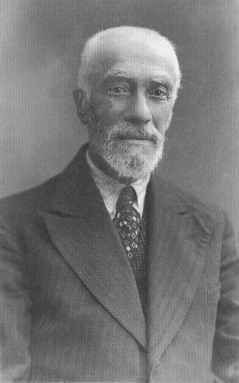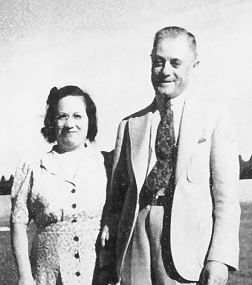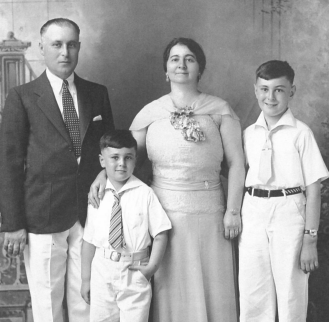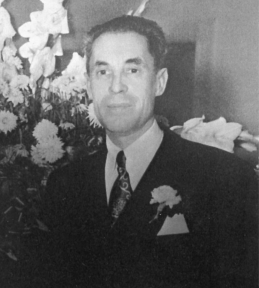|
|
The Rogoainsky's of Holinka
As told
by
Louis Rosen (Rogoainsky) to his son
Arnold Rosen in 1977 and submitted by Lester Rosen
"The
town that I was born in was named Holinka, which around the turn of the
century was part of Russia, located near the German border. It was
situated three Russian miles from Grodna, the nearest large city in the
area. My parents,
Yakov Dovid and Yetta Rogoainsky, were running a small grocery business and they used to
travel to Grodna to do their buying. When I was about seven or eight, my
father used to take me with him to do his shopping and I considered it a
tremendous treat to cross the River Niemen into Grodna. To me it was a
marvelous city. Actually, it wasn't anything to rave about.
In
Holinka we lived in a house facing the village square. In front of the
square were the better homes for the town officials: the priest of the
Russian Church, the teacher and principal of the Russian school. On one
side of the square was the church and on the other the synagogue where
we used to pray. Once a year, during spring, we had a fair where
itinerant merchants would set up their wagonloads of merchandise. That
was a big day for me because one of the wagons sold a special kind of
cake for a groshen or a penny apiece. Our street was not paved. In the
winter it was very cold and full of snow; in the spring it was muddy and
in the summer it was sandy. I didn't mind that.
There
were probably 400 people in Holinka, mostly Jewish, about 100 families.
There was no "upper crust" in that town because there were lots of poor
Jews, mostly peddlers, scrounging around the countryside trying to make
a buck, a ruble. We had only one man who might be called upper crust. He
was looked up to by some, but despised by most of the old timers because
he wore a hat, shirt and tie. He subscribed to the Jewish Daily and he
was called "der Deutsch" or "the German," a sneering term. He operated a
business and had the only dry goods store in the town, a miniature
department store. His son didn't want to go to cheder
(traditional elementary school teaching the basics of Judaism and
the Hebrew
language)
so he had a private tutor and wound up in the gymnasia or public high
school. He wore a uniform and talked Russian. This family was our next
door neighbor, but they were aloof. We had nothing to do with them.
The house in Holinka that I lived in was built of logs and there were
shingles on the roof. Most of the houses in the town had thatched roofs.
The barn in back of our house had a thatched roof. On the left side of
the house was a store where we kept and sold groceries. On the right
side was the living area - a front room, a dining room and a large
kitchen with a stove and built-in oven. It was a big Russian-type oven.
It had a little opening, like an entrance to a cave, over the top of the
oven. You could crawl in and take a nap. My grandfather and I used to
take siestas on top of the oven. I used to love to do that. There were a
couple of bedrooms on both sides of the kitchen, an outhouse in the yard
and a barn where we kept a cow and a horse. The floor of the house was
made of clay or mud, packed down hard. We used to cover it with fine,
yellow sand. Every so often we'd sweep out the old sand and dirt with a
besom (broom) made out of twigs and cover the floor with fresh
yellow sand. For furniture we had chairs, tables, chests of drawers and
benches. The beds had mattresses made out of packed straw, but the
coverings were composed of down feathers. In wintertime it could be
cold, especially far from the oven. But the house was very well
insulated. Between the logs, in the chinks, there was always packed moss
or some such material.
There was no electricity. We had kerosene lamps most of the time. We
also had candles, but they were lighted only on Friday night for
Shabbat. On Saturday night only one candle, the havdalah candle, was
lit. We drew water out of a well on the square. The well was called a
brunnem. It had a bucket and pulley, and everybody drew their water from
it. In early fall, the peasants used to bring loads of wood into the
square. Whoever needed it would go and haggle with the peasant and buy a
load of wood. It would all be cut up and ready for the oven.
Although we lived near them, I didn't have any contact with the town
officials. We had a policeman, an officer, who would be drunk most of
the time. He'd walk around in his uniform with a saber and everyone
would kowtow (show respect) to him.
About that same time I remember being brought into the cheder by my
father. They made a big to-do about showing me the aleph-bet. They gave
me ruhzhinkes and mondle (raisins and almonds). If you learned
well, then you would eat ruhzhinkes and mondle. Cheder was a terrible
drudge. I would be brought there early in the morning and confined in a
big room with other kids until dark. It got monotonous very fast, but we
all endured it. That was the life kids led in the village. The rebbe was
not modern. He would wield the stick if you irritated him in the least,
he didn't mind whipping you.
The rebbe in the school was the teacher, a melamed. The spiritual leader
of the village was the "Ruv," the Rabbi. I remember him as an aged
person with what they call a "hadtlass punim," an imposing face with a
long, flowing white beard. He was constantly at the books. He wasn't
like the modern Rabbi. I only heard him make a sermon on Yom Kippur Eve.
He was a very important person. As soon as he arrived in the shul, the
davening would start. The Rabbi was seated right next to the oren kodesh
on the mizrach, or eastern, wall. Only important people in the village
had seats near the Rabbi. Anyone who had a seat adjoining the eastern
wall was somebody. To sit there one had to be wealthy or well educated
or elderly, or better yet, a combination of all three.
The Jews of Holinka naturally spoke Yiddish. Even thought the town was
part of Russia, the gentiles of the area mostly spoke Polish, a few
Lithuanian. My father was fluent in Polish, but I only learned a
smattering of the language that I quickly forgot when I started learning
English.
At one time an order
came down that all the cheder kids would have to spend some time in
school learning Russian. I must have been about six. I was introduced to
the class, given a Russian book, but I didn't spend much time there. Why
the order was changed, I don't know. Somebody was probably paid off."
 Listen to audio stories by Louis Rogozinsky
Listen to audio stories by Louis Rogozinsky

|
|
The Minsky's of Holinka
Submitted by
Deborah Dworski

Nosson (Natan) MINSKY, a resident of Holinka.
He along with his wife Etta (HOLZMAN),
and approximately half
of their offspring,
were murdered in the Holocaust. The
three men below are sons of Nosson.

Shmerl (Sam) MINSKY was born in Holinka
in 1888 and later immigrated to the USA.
He was an insurance agent who lived
in Dorchester, MA. He is shown here
with his wife Bessie (WARTELSKI). He
changed his name to Sam MINSE and
died in Boston in 1967 at the age of 80.

Mordechai (Max) MINSKY was born in Holinka
in 1890 and later immigrated to the USA.
He lived in Haverhill, MA and is shown here
with his wife May (FIMAN) and children.
He served in WWI and died in
in 1944 at the age of 54.

Shloime (Sol) MINSKY was born in Holinka
in 1895 and immigrated to Boston, MA.
He later moved to Washington, DC
where he was a grocer. There he met
and married Ida (LIPSHITZ). He died
in 1976 at the age of 81.
Escape by Hay Wagon...
Shared by Lester Rosen
Max Rosen and his wife Sarah decided to leave Holinka before he would be
eligible for the Russian army draft. His younger brother Morris prepared a special hay wagon pulled by a
horse. He put Max and Sarah in the center
of the haystack. The wagon then traveled across the border to sell the hay to a merchant
in Germany (Prussia). The
border soldiers examined the wagon, even sticking bayonets into
the hay, but the son and wife were well concealed and got across the
border safely.*
Of all the members of the Rogoainsky family, only two sons, Max and Morris
Rosen,
emigrated from Holinka.
* Comment by R. Remick: My own maternal grandfather, whose passport was
issued in the same village of Hołynka,
was smuggled out of the Russian Empire in a hay wagon, traveling mostly
by night and resting during the day. He left before being drafted into the Czar's army. At age 20 he made his way to Antwerp, Belgium arriving in Montreal, Que.
From there to Detroit, Mi, and settling in Milwaukee, Wi. He learned English in addition to four other known languages. He was a glassblower for Corning Glass Works in Corning, NY, working on the first television picture tube.
Hołynka Residents during WWII
There is little documented evidence of how the Hołynka (Golinka) community survived during World War II. However there are a few documents that give us some knowledge of those who were arrested, tortured, or killed.
The following is shared by the Holocaust Museum.  Click to view WWII Golinka victim names Click to view WWII Golinka victim names
Execution site of 3,000 Jews in Navumavičy - 10 km (6.2 miles) from Holinka (by Yahadmap.org).  Click to view information on memorial site Click to view information on memorial site
| |





